battery capacity AUDI A4 1998 B5 / 1.G Battery Workshop Manual
[x] Cancel search | Manufacturer: AUDI, Model Year: 1998, Model line: A4, Model: AUDI A4 1998 B5 / 1.GPages: 29, PDF Size: 0.19 MB
Page 10 of 29
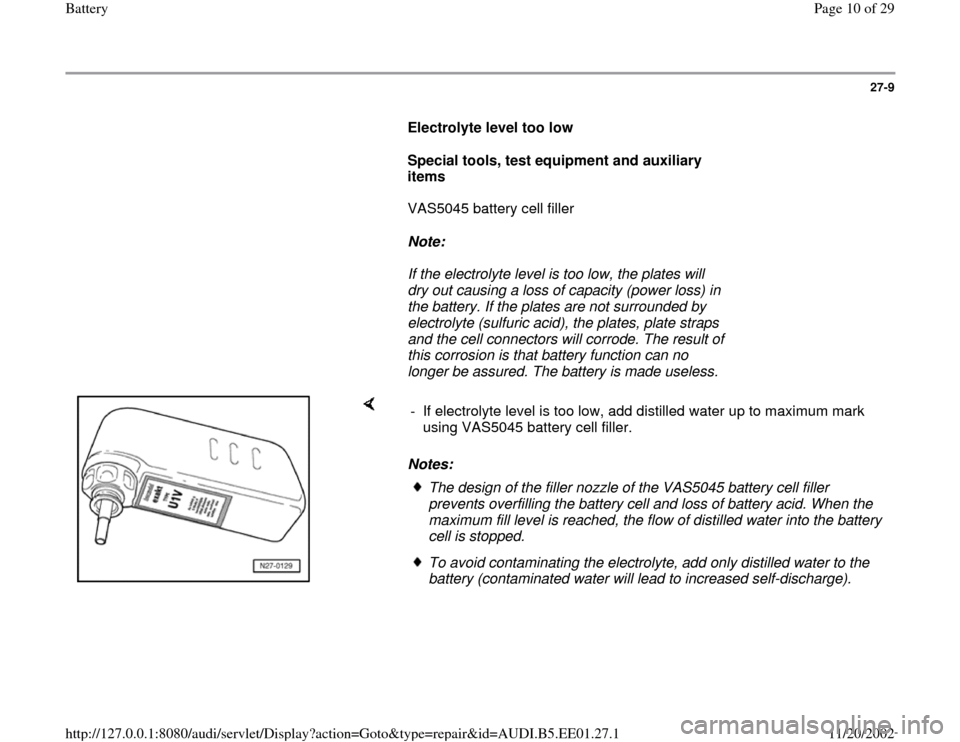
27-9
Electrolyte level too low
Special tools, test equipment and auxiliary
items
VAS5045 battery cell filler
Note:
If the electrolyte level is too low, the plates will
dry out causing a loss of capacity (power loss) in
the battery. If the plates are not surrounded by
electrolyte (sulfuric acid), the plates, plate straps
and the cell connectors will corrode. The result of
this corrosion is that battery function can no
longer be assured. The battery is made useless.
Notes: - If electrolyte level is too low, add distilled water up to maximum mark
using VAS5045 battery cell filler.
The design of the filler nozzle of the VAS5045 battery cell filler
prevents overfilling the battery cell and loss of battery acid. When the
maximum fill level is reached, the flow of distilled water into the battery
cell is stopped. To avoid contaminating the electrolyte, add only distilled water to the
battery (contaminated water will lead to increased self-discharge).
Pa
ge 10 of 29 Batter
y
11/20/2002 htt
p://127.0.0.1:8080/audi/servlet/Dis
play?action=Goto&t
yp
e=re
pair&id=AUDI.B5.EE01.27.1
Page 22 of 29
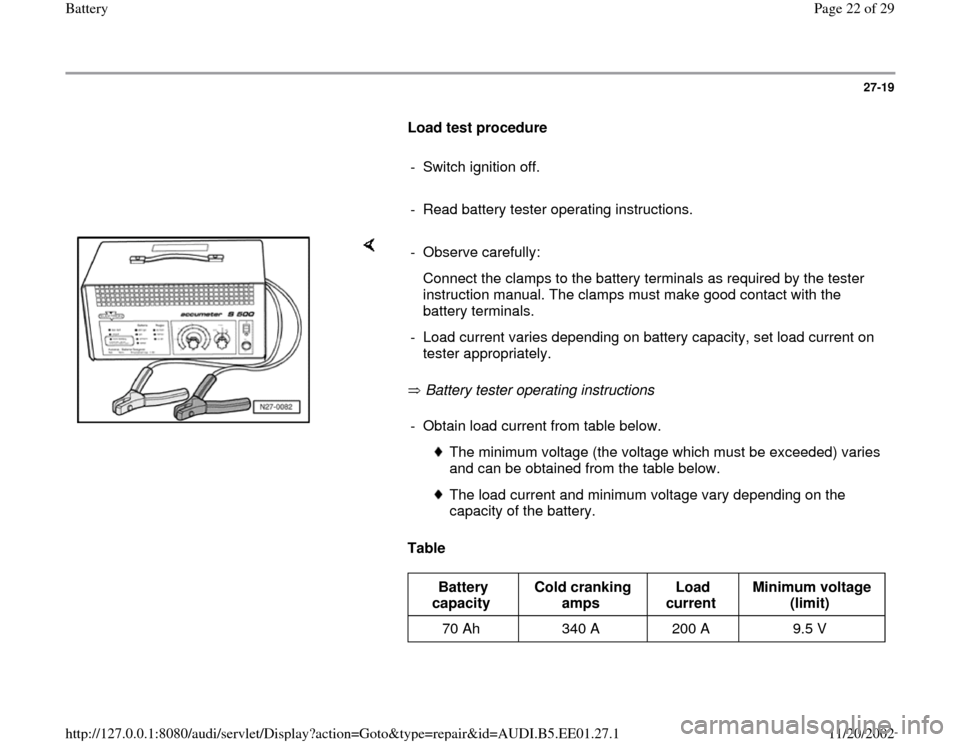
27-19
Load test procedure
- Switch ignition off.
- Read battery tester operating instructions.
Battery tester operating instructions
Table - Observe carefully:
Connect the clamps to the battery terminals as required by the tester
instruction manual. The clamps must make good contact with the
battery terminals.
- Load current varies depending on battery capacity, set load current on
tester appropriately. - Obtain load current from table below.
The minimum voltage (the voltage which must be exceeded) varies
and can be obtained from the table below.
The load current and minimum voltage vary depending on the
capacity of the battery. Battery
capacity Cold cranking
amps Load
current Minimum voltage
(limit)
70 Ah 340 A 200 A 9.5 V
Pa
ge 22 of 29 Batter
y
11/20/2002 htt
p://127.0.0.1:8080/audi/servlet/Dis
play?action=Goto&t
yp
e=re
pair&id=AUDI.B5.EE01.27.1
Page 23 of 29
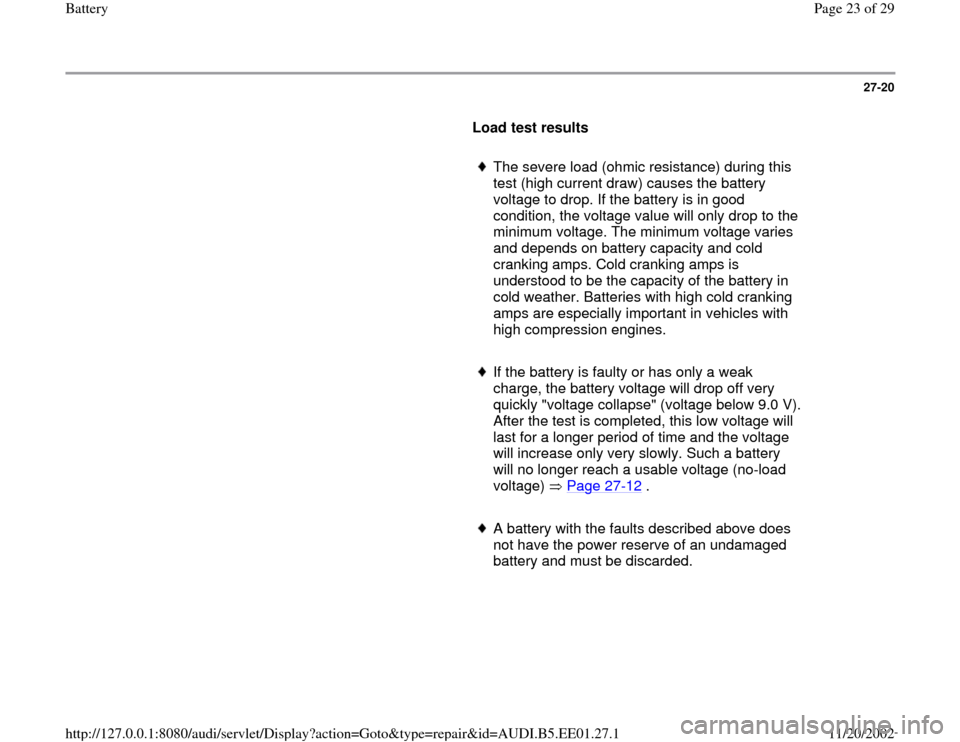
27-20
Load test results
The severe load (ohmic resistance) during this
test (high current draw) causes the battery
voltage to drop. If the battery is in good
condition, the voltage value will only drop to the
minimum voltage. The minimum voltage varies
and depends on battery capacity and cold
cranking amps. Cold cranking amps is
understood to be the capacity of the battery in
cold weather. Batteries with high cold cranking
amps are especially important in vehicles with
high compression engines.
If the battery is faulty or has only a weak
charge, the battery voltage will drop off very
quickly "voltage collapse" (voltage below 9.0 V).
After the test is completed, this low voltage will
last for a longer period of time and the voltage
will increase only very slowly. Such a battery
will no longer reach a usable voltage (no-load
voltage) Page 27
-12
.
A battery with the faults described above does
not have the power reserve of an undamaged
battery and must be discarded.
Pa
ge 23 of 29 Batter
y
11/20/2002 htt
p://127.0.0.1:8080/audi/servlet/Dis
play?action=Goto&t
yp
e=re
pair&id=AUDI.B5.EE01.27.1
Page 26 of 29
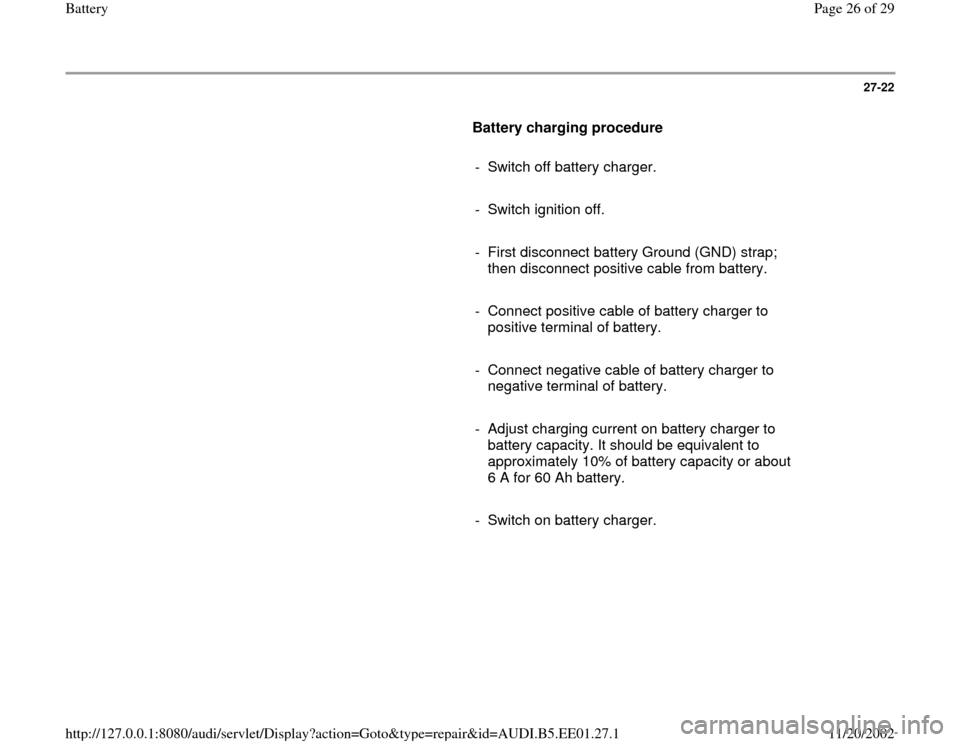
27-22
Battery charging procedure
- Switch off battery charger.
- Switch ignition off.
- First disconnect battery Ground (GND) strap;
then disconnect positive cable from battery.
- Connect positive cable of battery charger to
positive terminal of battery.
- Connect negative cable of battery charger to
negative terminal of battery.
- Adjust charging current on battery charger to
battery capacity. It should be equivalent to
approximately 10% of battery capacity or about
6 A for 60 Ah battery.
- Switch on battery charger.
Pa
ge 26 of 29 Batter
y
11/20/2002 htt
p://127.0.0.1:8080/audi/servlet/Dis
play?action=Goto&t
yp
e=re
pair&id=AUDI.B5.EE01.27.1
Page 27 of 29
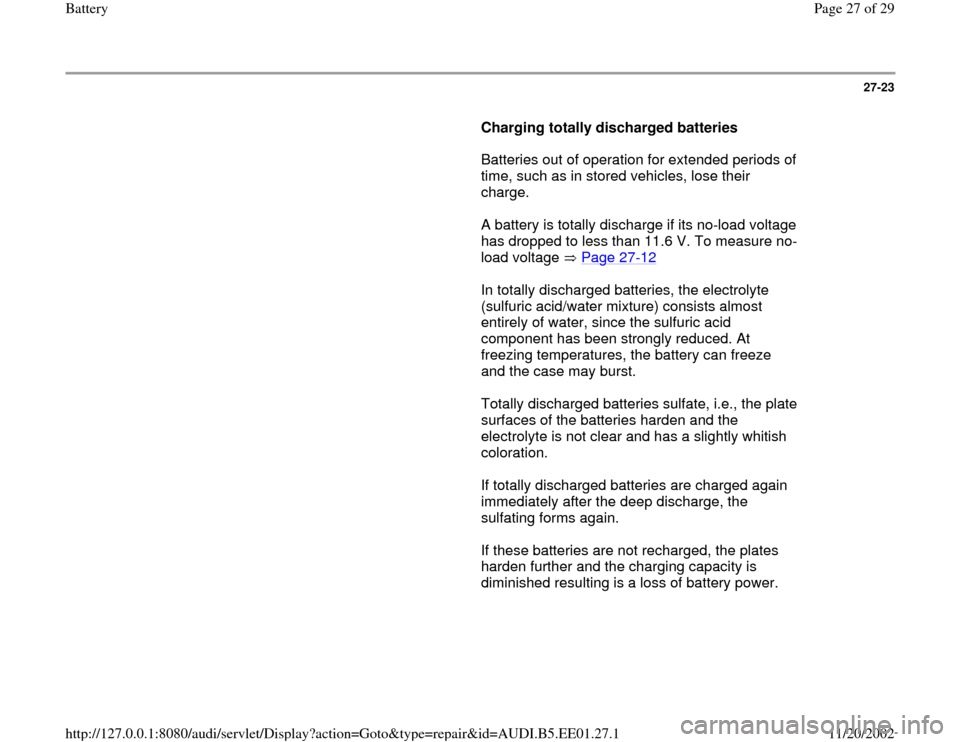
27-23
Charging totally discharged batteries
Batteries out of operation for extended periods of
time, such as in stored vehicles, lose their
charge.
A battery is totally discharge if its no-load voltage
has dropped to less than 11.6 V. To measure no-
load voltage Page 27
-12
In totally discharged batteries, the electrolyte
(sulfuric acid/water mixture) consists almost
entirely of water, since the sulfuric acid
component has been strongly reduced. At
freezing temperatures, the battery can freeze
and the case may burst.
Totally discharged batteries sulfate, i.e., the plate
surfaces of the batteries harden and the
electrolyte is not clear and has a slightly whitish
coloration.
If totally discharged batteries are charged again
immediately after the deep discharge, the
sulfating forms again.
If these batteries are not recharged, the plates
harden further and the charging capacity is
diminished resulting is a loss of battery power.
Pa
ge 27 of 29 Batter
y
11/20/2002 htt
p://127.0.0.1:8080/audi/servlet/Dis
play?action=Goto&t
yp
e=re
pair&id=AUDI.B5.EE01.27.1
Page 28 of 29
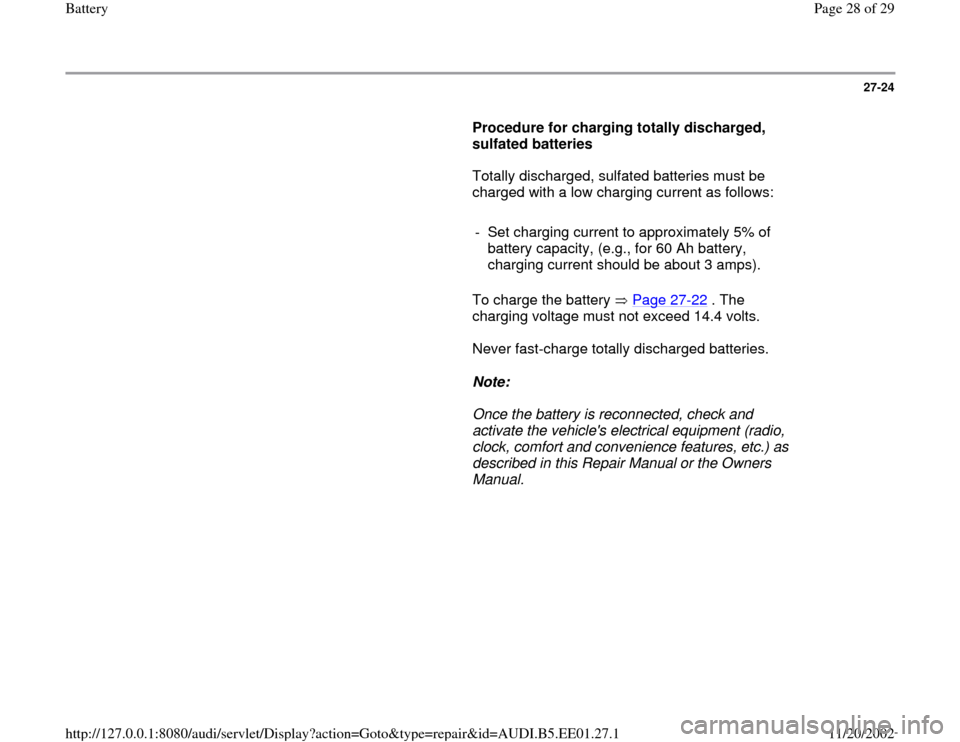
27-24
Procedure for charging totally discharged,
sulfated batteries
Totally discharged, sulfated batteries must be
charged with a low charging current as follows:
- Set charging current to approximately 5% of
battery capacity, (e.g., for 60 Ah battery,
charging current should be about 3 amps).
To charge the battery Page 27
-22
. The
charging voltage must not exceed 14.4 volts.
Never fast-charge totally discharged batteries.
Note:
Once the battery is reconnected, check and
activate the vehicle's electrical equipment (radio,
clock, comfort and convenience features, etc.) as
described in this Repair Manual or the Owners
Manual.
Pa
ge 28 of 29 Batter
y
11/20/2002 htt
p://127.0.0.1:8080/audi/servlet/Dis
play?action=Goto&t
yp
e=re
pair&id=AUDI.B5.EE01.27.1
Page 29 of 29
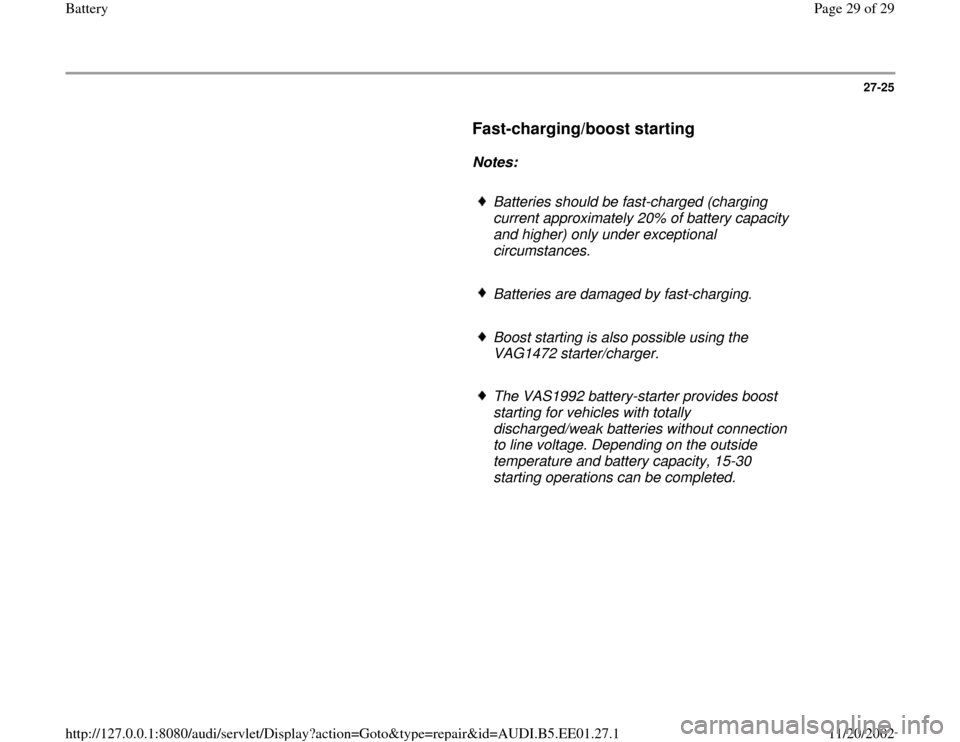
27-25
Fast-charging/boost starting
Notes:
Batteries should be fast-charged (charging
current approximately 20% of battery capacity
and higher) only under exceptional
circumstances.
Batteries are damaged by fast-charging.
Boost starting is also possible using the
VAG1472 starter/charger.
The VAS1992 battery-starter provides boost
starting for vehicles with totally
discharged/weak batteries without connection
to line voltage. Depending on the outside
temperature and battery capacity, 15-30
starting operations can be completed.
Pa
ge 29 of 29 Batter
y
11/20/2002 htt
p://127.0.0.1:8080/audi/servlet/Dis
play?action=Goto&t
yp
e=re
pair&id=AUDI.B5.EE01.27.1